
Businesses operating online are connected to a world wide web of potential customers, but you’re also exposed to several risks — sometimes at the hands of those same consumers.
To keep your business safe, I recommend having a terms and conditions agreement, which you can easily make using a template.
A website or mobile app’s terms and conditions policy outlines guidelines users are expected to follow and covers topics like dispute resolutions, payment terms, and more.
Read on to learn more about terms and conditions agreements, why you should have one, and how to implement one using our sample terms and conditions template.
Key Takeaways
Here’s a quick summary of everything you need to know about website’s terms and conditions agreements:
Ready to get your hands on a free terms and conditions template? Check out the sample below and then download our template in one the following ways:
Last updated [Date]
AGREEMENT TO TERMS
These Terms and Conditions constitute a legally binding agreement made between you, whether personally or on behalf of an entity (“you”) and [business entity name] (“we,” “us” or “our”), concerning your access to and use of the [website name.com] website as well as any other media form, media channel, mobile website or mobile application related, linked, or otherwise connected thereto (collectively, the “Site”).
You agree that by accessing the Site, you have read, understood, and agree to be bound by all of these Terms and Conditions. If you
After you download the document, change the purple text so it accurately reflects different details about your business.
Our terms and conditions sample text is suitable for the following websites and platforms:
A terms and conditions agreement outlines the rules and expectations people must follow when accessing your website or mobile app and informs them about what they can expect from you.
Whether you call it a terms of use, terms of service, or terms and conditions, this powerhouse document helps maintain control over your site as long as your guidelines fall within applicable laws by explaining the following:
It answers several common customer service questions and provides clear protocols if users try to take advantage of your operations.
It’s also required by some parties if you’re engaging in certain behaviors such as using an SMS broadcast service.
You can easily make one for your website or app by filling in the blank sections of a terms and conditions template with relevant information about your business protocols and guidelines.
Terms and conditions agreements aren’t legally required, but it’s in your best interest to post one on your website or mobile app because it provides an additional layer of legal protection.
In the event of a dispute, arbitrators may consider multiple facets of your T&C document to determine whether each party acted within their rights.
While it’s not guaranteed to hold up in court, you have a better chance if you can prove your users read and agreed to the policy.
According to the American Bar Association (ABA), some specific legal disclosures apply to certain transactions and must be made as written statements, like stipulations outlined by:
You can add these disclosures as clauses in your website’s terms and conditions agreement.
Terms and conditions aren’t legally required, but privacy policies and cookie policies are.
There are several reasons why you should post a terms and conditions on your website or app, as this document helps:
The clauses you should include in your terms and conditions agreement varies depending on your industry and how consumers interact with your website or app.
To help you out, I’ve compiled a gigantic list of the most common clauses that appear in terms and conditions agreements.
Your terms and conditions agreement should start with an introduction letting users know what they’re reading, who you are, and to who the terms apply.
Within this clause, explain that anyone using your service must follow the terms and continuing to operate your platform implies they agree to them — this is called implied or browsewrap consent and is standard in most website terms and conditions documents.
See an example of this terms and conditions clause from the electronics company Apple below.

Your terms and conditions should also have an intellectual property clause informing users about your ownership rights, copyrights, and trademarks.
Simply state that by agreeing to your website terms and conditions, users agree that:
Below, see a sample of how media group Vox Media Company phrases this clause in their terms and conditions agreement.

For websites in the U.S., your terms and conditions must explain that you’ll remove material that infringes users’ copyright according to the Digital Millennium Copyright Act (DMCA) as required by US copyright laws.
Below, see another sample of this terms and conditions clause from Vox.
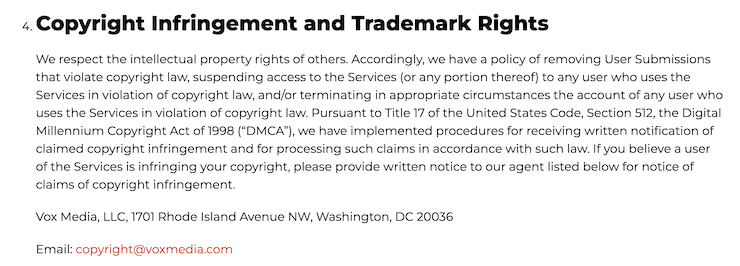
If your site or app allows users to create and share content, include a contribution clause in your terms and conditions explaining their rights over their posts.
Take, for example, YouTube’s contribution clause, which explains what rights content creators retain over the videos they share.
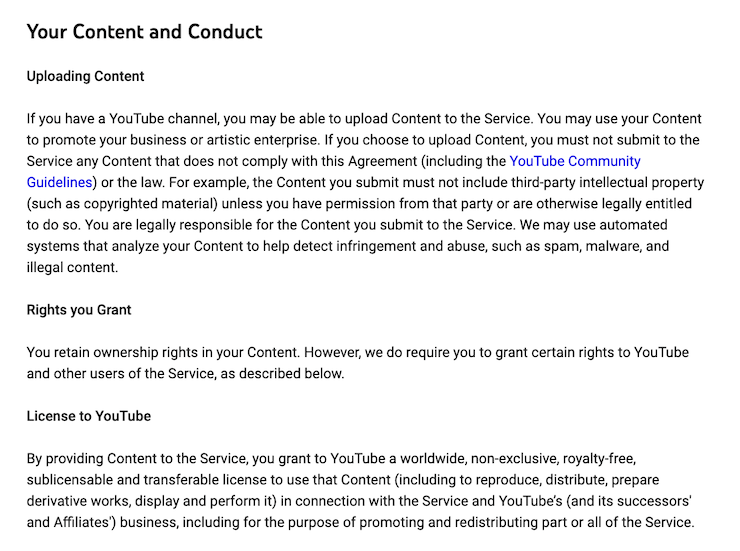
If your website links to external sources, put a third parties clause in your terms and conditions agreement explaining that you’re not responsible for the content on the sites you link to.
Below, see an example of how Vox discloses third-party links in their terms and conditions.
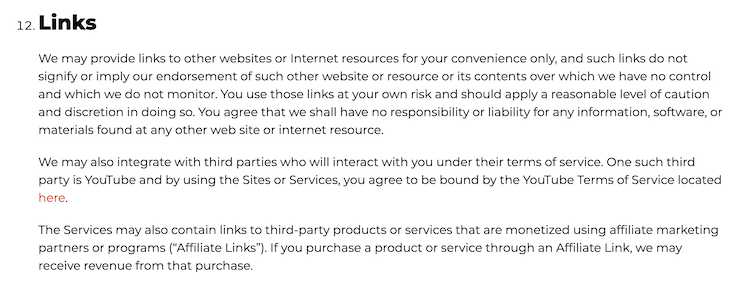
If your site allows users to create user profiles, add a user registration clause to your terms and conditions template to set proper customer expectations.
Here, you can remind users that their user credentials should always be kept confidential, they’re responsible for keeping it safe, and they need to contact you immediately if their credentials get stolen or someone gains unauthorized access to their account.
Below, see a sample of this clause in Spotify’s terms and conditions agreement.

If you allow users to interact with one another on your website or app, include an acceptable use clause in your terms and conditions to outline what actions and behaviors are permitted, including following other policies and terms.
Check out how the popular travel app Hopper informs users of acceptable use:

If it makes sense for your business, you can separate these rules into a standalone acceptable use policy (AUP) document that’s easier to share with your audience.
Just remember to establish that it’s still part of your overall terms.
You should also include a clause in your terms and conditions that explicitly lists prohibited activities to stop visitors from misusing your site.
Most companies will ban users for the following:
Below, see another example from Hopper’s terms and conditions.
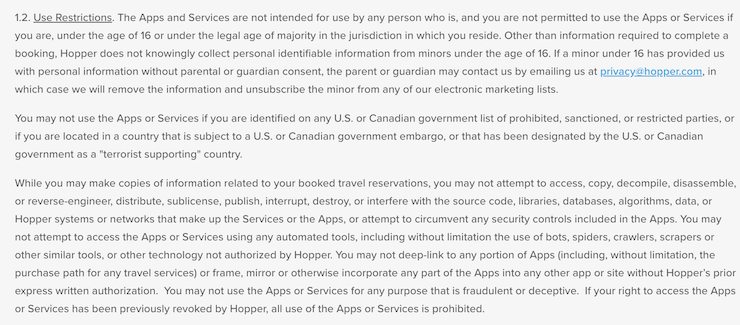
In your terms and conditions template, adding a suspension and terminations clause protects your site or app from abusive users by outlining your right to suspend accounts that violate your terms and delete their content.
You can also explain how users can delete or terminate their own accounts, which is particularly useful if you offer Software-as-a-service (SaaS) applications.
Below, see an example of this clause from the terms and conditions for the ecommerce company Etsy.
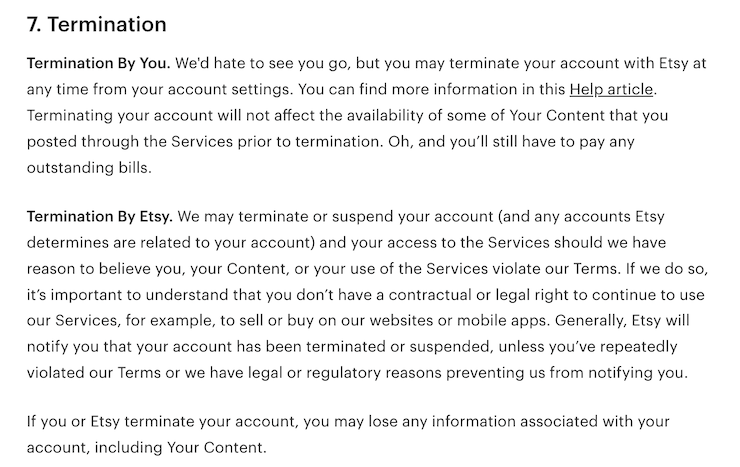
Add a site management or support clause to tell users how you run your site or service and to give users a better understanding of how your service works.
Companies typically outline the following details:
Below, see how Spotify phrases this clause in their terms and conditions agreement.
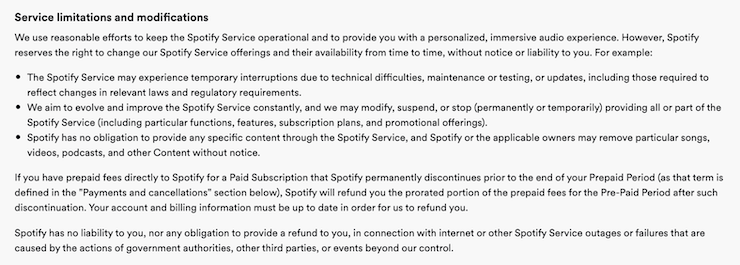
Include a section in your terms and conditions explaining your payment terms, like:
Use phrases such as “as available” for services and “as provided” for items to lower the chances of disputes.
Below, see a sample of this clause from the mobile service provider Spotify’s terms and conditions agreement.

Your terms and conditions agreement is a great place to link to your shipping policy and outline some of your processes, as this helps answer common customer service questions.
Below, see an example of how clothing retailer ASOS phrases this clause in their terms and conditions agreement.
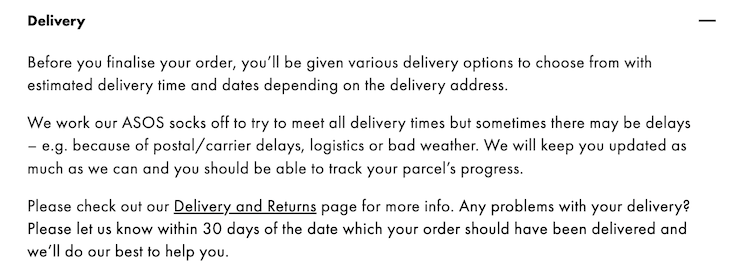
If you run an ecommerce website or app, put a returns and refunds clause in your terms and conditions so customers can always easily find this information.
Here you can provide a link to your official return policy along with a summary of your practices.
Below, see another example clause from ASOS.
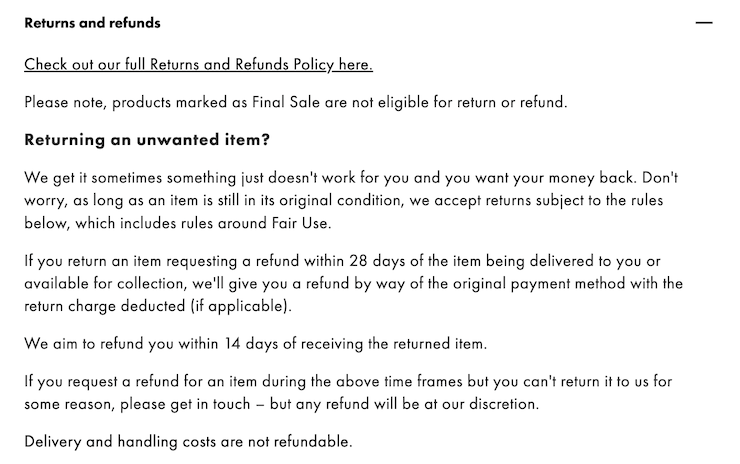
It’s a business best practice to add a privacy policy clause in your terms and conditions agreement and include a live link to the official policy to helps ensure your users can always locate this vital legal document.
See how T-Mobile phrased this clause in their terms and conditions in the screenshot below.

Keep in mind that there are additional guidelines you need to follow with your privacy policy because different data privacy regulations around the globe dictate the specifics.
If you manufacture and sell products, put a limitations of liability clause in your terms and conditions agreement, also called a no responsibility clause.
Businesses use this clause to limit what customers can hold them accountable for, and it usually features standard language, as shown in the example below from Apple.
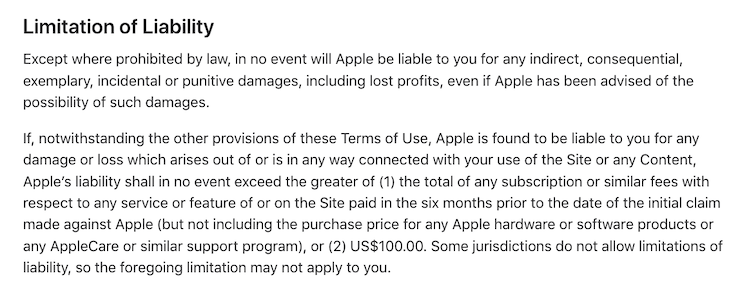
In your terms and conditions agreement, you can establish within a clause what national or state law governs the contract between you and the users.
Most companies choose the law of their state or country or the country where users access their site or app.
See an example of this terms and conditions clause from Spotify below.

You should also establish how you agree to handle consumer disputes within your terms and conditions. Typically this goes in a dispute resolution or indemnification clause.
Below, see another example from Spotify.

We’re all human, so within your terms and conditions agreement, include a clause that reminds users that you’re not liable for mistakes or errors on your site.
This section covers your back just in case there are any inconsistencies in your content, allowing you to update it with the correct information at any time.
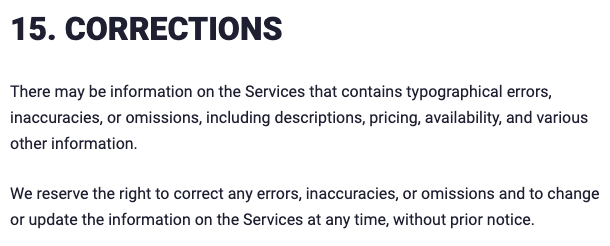
You should also add a modifications and interruptions clause to your terms to limit your liabilities if users claim any loss or damage because they can’t use your site.
Here you can explain your right to change or delete anything on your site and states that users may encounter hardware problems and downtime.
Here’s another example from our own terms and conditions of how to phrase this section.
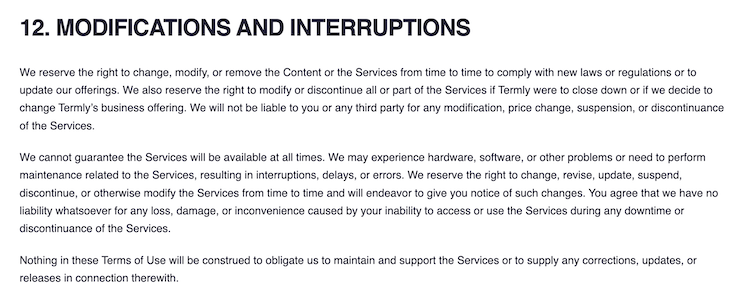
A disclaimer and warranties clause in your terms and conditions lets users know that your site is available on an “as-is and as-available basis” and to use it at their own risk.
Essentially, this clause states that you are not responsible for any damage your service, product, or website may cause a user.
Below, see an example of a disclaimer warranty from Spotify.
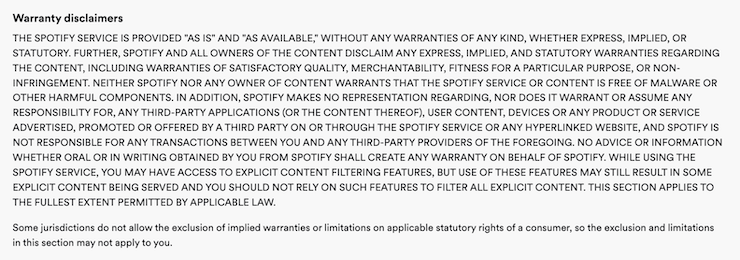
Our free basic disclaimer template includes these terms and more.
Finally, you need to inform readers how they can reach you if they have any questions or concerns about your service and policies, so put those details in a clause at the end of your terms and conditions agreement.
Below, see an example of this clause from Etsy, who keeps it short and sweet.

Now that you know what goes into this agreement, let’s discuss the different ways you can make terms and conditions for your site.
Using a managed solution, like our Terms and Conditions Generator, is the simplest way to make one of these agreements for your website or mobile app.
You read through that giant list of clauses — making such an extensive document can take up a lot of time and effort.
Our Terms and Conditions Generator does all the hard work for you. You only need to answer a few simple questions about your business.
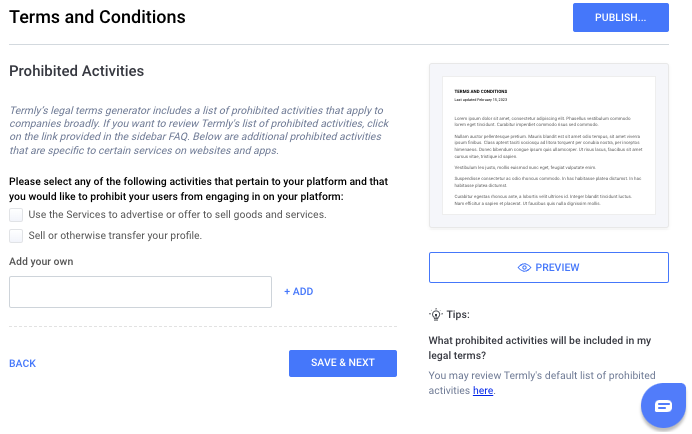
Our legal team added useful Tips and included answers to frequently asked questions in the policy builder, too. But if you need any help along the way, contact our customer service team.
Use a terms and conditions template for a simple, no-cost solution for your website or app.
Terms and conditions templates are free to download, fully customizable, and easy to use. Our terms and conditions template works for websites and mobile apps, features the most common clauses, and is written in plain language.
You simply fill in the blank sections of each clause with information about your business and manually change the formatting to remove or add any clauses as needed.
Choose how you want to download it, then add the template directly to your website or app.
You can take a do-it-yourself approach and write a terms and conditions agreement on your own, which is a good approach if you have a legal team or run a unique business that requires non-traditional clauses.
But the cons of writing it yourself are hard to ignore — these agreements are challenging to make, and it’s easy to miss vital clauses.
Making a terms and conditions agreement can be tricky — here are some of my best tips on how to write a good terms and conditions agreement.
Once you’ve created a terms and conditions agreement, you need to display it in a prominent area of your website or app, and I recommend the following places:
To enforce your terms and conditions agreement, if helps if you can prove that your users consented to it, read the contents, and fully understood what they agreed to.
Merely having a terms and conditions page and placing links throughout your website isn’t enough to get agreement, at least in the eyes of the courts.
You can obtain consent to your agreement by utilizing both the clickwrap and browsewrap methods:
You also need to ensure the formatting of your terms and conditions is easy to follow and that it’s written clearly and in a straightforward way.
Courts might also consider additional details, like if the link is easy to find on your platform and the different times it was presented to the user.
Taking inspiration from other sites’ terms and conditions can help inspire you when making your own, so let’s go over some great example terms and conditions agreements together.
First, let’s take a look at McDonald’s for a sample of a good terms and conditions agreement.
To keep visitors informed about updates to their terms and conditions agreement, McDonalds puts the information in a pop-up banner that appears when you arrive on their webpage, as shown below.

I also love how easy it is to read McDonald’s terms and conditions clauses, which are written in a simple, straightforward way that matches their brand, as shown in the screenshot below.

Throughout their policy, McDonald’s bolds parts of their content they want users to pay closer attention to, something you can consider doing in your own agreement.
See an example of this formatting in the screenshot below of their acceptable and prohibited uses clause for their online services.

Another strong terms and conditions example comes from one of the world’s largest telecommunications companies, AT&T.
AT&T’s terms and conditions are incredibly detailed and comprehensive.
As shown below, the company uses a clickable table of contents to make their terms easier to navigate through. Consider doing the same if you have lengthy terms and conditions.
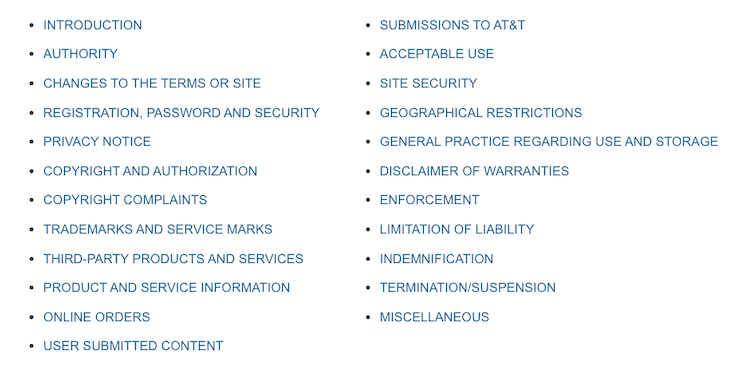
In their agreement, AT&T gives special consideration to passwords and security because it collects a substantial amount of personal data from customers.
At the same time, they limit their liabilities by controlling user expectations, as shown in the screenshot of their security clause below.
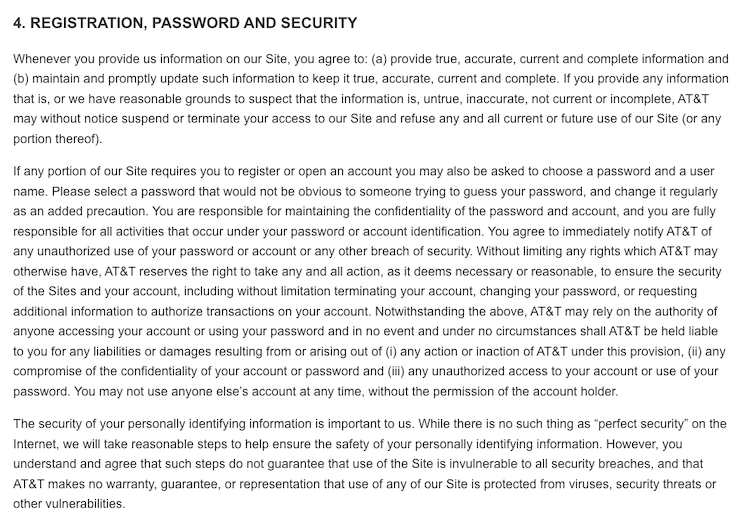
Finally, let’s look at Apple’s terms and conditions for our final example, a tech company with a well-crafted agreement we’ve already referenced in this guide.
Apple’s terms clearly define what is considered an acceptable use of their services and what is not, as shown in the screenshot below.
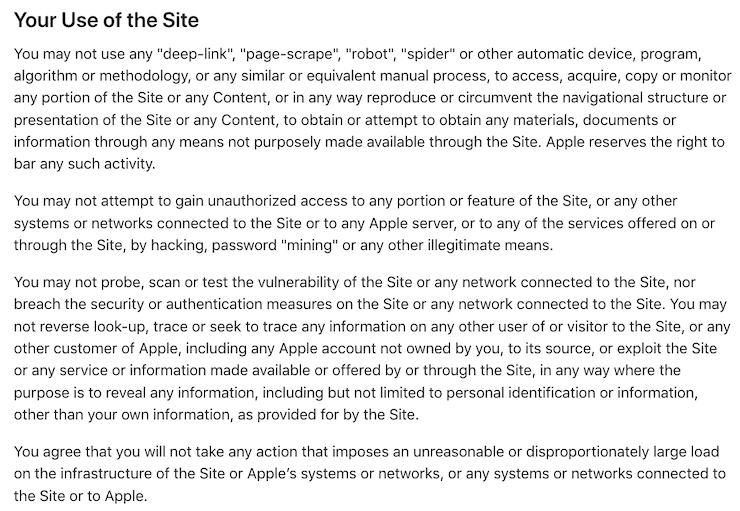
I also like how Apple provides links to additional policies relevant to their consumers directly within their terms and conditions, shown below.
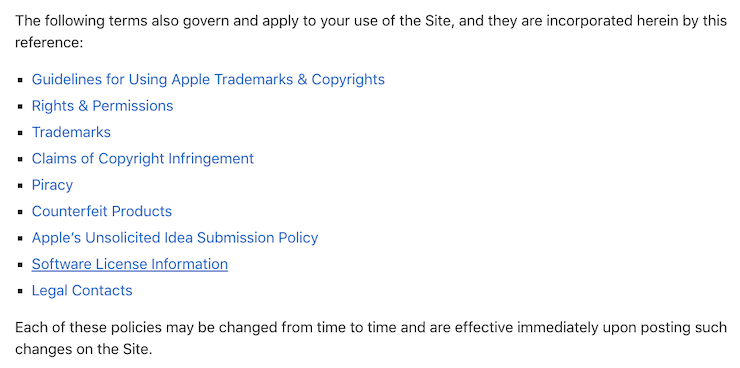
I recommend you do the same thing as Apple and put links to your privacy policy, shipping policy, and return and refund policies within clauses in your terms.
Check out the most frequently asked questions we get about terms and conditions policies below.
No, a terms and conditions agreement is not legally required, but it’s a business best practice to have one in place, as it helps:
Terms and conditions agreements can be legally binding if you prove your users read and consented to the document.
But it may be circumstantial and other factors will also be considered.
There are several benefits of having a terms and conditions agreement, here are just a few:
The clauses you should put in your terms and conditions depend on the industry you’re in and how you allow users to access your website or mobile app, but here is a list of the most common clauses:
Your terms and conditions should be readily accessible, so display them in the following places:
To help make your terms and conditions agreement enforceable, implement all of the following:
Yes, terms and conditions, terms of use, and terms of service refer to the same agreement.
Or, if you’re looking for a different type of terms and conditions template, check out our other options to find what you need:
| Terms and Conditions Template | Description |
| Mobile App Terms and Conditions Template | Terms and conditions for apps in various app stores |
| E-commerce Terms and Conditions Template | Terms for e-commerce sites and online shops |
| Terms of Service Template | For those who prefer terms of service |
| Terms of Use Template | For those who prefer terms of use |
If your business runs a website or mobile app, it’s in your best interest to have a terms and conditions agreement to set proper customer expectations and limit your exposure to unnecessary legal or financial risks.
A comprehensive terms and conditions agreement will give you control over:
After you’ve finished your terms and conditions, put it in prominent places throughout your website, like the footer and payment screens, so your users can always access it.
There’s no need to reinvent the wheel when making this agreement for your site. Get a head start by downloading and customizing our free terms and conditions template.

Masha is an Information Security and Data Privacy Specialist and a Certified Data Protection Officer. She has been a Data Protection Officer for the past six years, helping small and medium-sized enterprises achieve legal compliance. She has also been a privacy compliance mentor to many international business accelerators. She specializes in implementing, monitoring, and auditing business compliance with privacy regulations (HIPAA, PIPEDA, ePrivacy Directive, GDPR, CCPA, POPIA, LGPD). Masha studied Law at Belgrade University, and she passed the Bar examination in 2016. More about the author